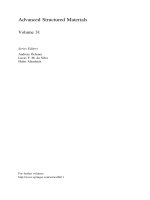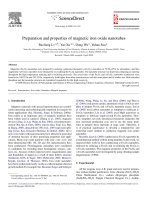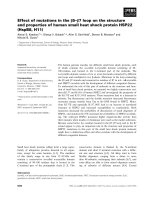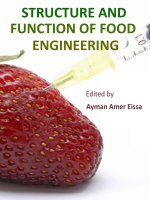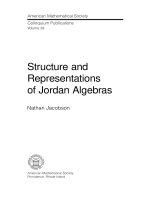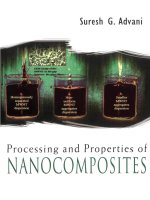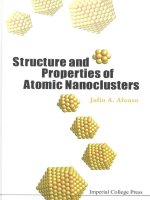- Trang chủ >>
- Khoa Học Tự Nhiên >>
- Vật lý
structure and properties of atomic nanoclusters, 2005, p.427
Bạn đang xem bản rút gọn của tài liệu. Xem và tải ngay bản đầy đủ của tài liệu tại đây (18.36 MB, 427 trang )
Structure and
Pronerties
of
Atomic Nanoclusters
This page intentionally left blank
Structure and
ProDerties
of
Atomic Nanoclusters
Julio
A. Alonso
Universidad de Valladolid, Spain
Imperial College Press
British Library Cataloguing-in-Publication Data
A catalogue record for this book is available from the British Library.
Published by
Imperial College Press
57 Shelton Street
Covent Garden
London WC2H 9HE
Distributed by
World Scientific Publishing Co. Pte. Ltd.
5 Toh Tuck Link, Singapore 596224
USA office: 27 Warren Street, Suite 401-402, Hackensack, NJ 07601
UK office: 57 Shelton Street, Covent Garden, London WC2H 9HE
Printed in Singapore.
For photocopying of material in this volume, please pay a copying fee through the Copyright
Clearance Center, Inc., 222 Rosewood Drive, Danvers, MA 01923, USA. In this case permission to
photocopy is not required from the publisher.
ISBN 1-86094-551-1
All rights reserved. This book, or parts thereof, may not be reproduced in any form or by any means,
electronic or mechanical, including photocopying, recording or any information storage and retrieval
system now known or to be invented, without written permission from the Publisher.
Copyright © 2005 by Imperial College Press
STRUCTURE AND PROPERTIES OF ATOMIC NANOCLUSTERS
Dedicated to Yolanda, Cristina, Victor, Alejandra and Helena.
This page intentionally left blank
Foreword
Towards the end of my stay as a postdoctoral fellow at the University of
Pennsylvania, I asked my supervisor, Professor
L.
A.
Girifalco, which
are the topics, in his opinion, that would be good for research in the
future. He suggested as one of the topics “small particles”, a term used in
the early
1980s
for an emerging field devoted to the study of small
groups of atoms, or atomic clusters
-
nanoscience was not yet a
fashionable term. This insightful advice was given a few years before the
two
key experimental discoveries in the field. One of those was the
observation and explanation of electronic shell effects in metallic
clusters in
1984.
The second was the detection, only a few months later,
of the fullerene cluster
C~O
and the proposal for its peculiar cage
structure. The First International Symposium on Small Particles and
Inorganic Clusters (ISSPIC-1) had taken place in Lyon in
1976.
With the
passing of time this symposium established itself as the main joint
activity in this field, and ISSPIC-12 took place in Nanjing in 2004. The
advice I received from Professor Girifalco gave me the motivation to
initially dedicate a modest fraction
of
my research effort to the study of
atomic clusters, and this involvement later increased until it became my
main research activity. Due to this interest I have been able to follow the
development of the now mature cluster field.
In this monograph
I
present some of the main developments in
atomic clusters and the actual status
of
the field. The range of topics
covered is broad, but evidently not comprehensive, and this is due to
several reasons. One is my own interest, which is reflected in the
selection
of
topics and illustrative examples. The second reason has to do
with the limitations of my knowledge of the field. Third, I consider an
in-depth presentation of a limited number of topics more adequate than a
lighter presentation of an enlarged list of topics or systems. Finally, I
have tried to achieve a proper balance between those considerations and
the size
of
the monograph.
vii
viii
Structure
and
Properties
of
Atomic Clusters
The book is intended to be useful to graduate students in the fields
of
Nanoscience, Molecular Sciences and Condensed Matter, and also to
scientists interested in entering the field
of
Atomic Clusters.
Contents
Foreword
vii
Acknowledgments
xv
1
.
Introduction to Clusters
1
1.1 The Field
of
Clusters
1
1.2 Types
of
Clusters
3
1.2.1 Van der Waals clusters
3
1.2.2 Metal clusters
4
1.2.3 Clusters
of
ionic materials
5
1.2.4 Network clusters
6
1.2.5
Cluster assembled solids
6
References
6
2
.
Experimental Production
of
Clusters
7
2.1 Formation
of
Clusters in Matrices
7
2.1.1 Chemical reaction in a liquid medium
7
2.1.2 Irradiation
of
a solid
8
2.1.4 Condensation on a substrate
9
2.3
Ion
Bombardment
10
2.4.1 Kinetics
of
coagulation
12
2.4.2 Seeded nozzle sources
13
2.4.3 Gas aggregation sources
13
2.4.4 Laser vaporization
14
2.1.3 Immersion
of
a
porous
glass
in a liquid metal
9
2.2 Liquid Metal Ion Source
10
2.4 Supersonic Nozzle Sources
10
2.4.5 Clusters in helium droplets
14
2.5 Mass Analysis
14
References
18
ix
X
Structure
and
Properties
of
Atomic
Clusters
3
.
Van der Waals Clusters
21
3.1 Structure of
Van
der Waals Clusters
21
3.3 Thermal Properties
31
3.3.1 Solid to solid transitions
31
3.2 Transition to the Bulk
28
3.3.2 Melting transition
33
3.3.3 Mixed inert gas clusters
42
3.3.4 Liquid to gas phase transition in hydrogen clusters
43
3.4 Electronic Effects
46
3.4.2 Core level spectroscopy
50
3.5
Clusters of SF6 and C02 Molecules
52
3.4.1 Delocalized electronic states of excess electrons
46
3.6 Interaction with Ultrafast Laser Pulses
54
References
56
4
.
Electronic and Atomic Shells in Metal Clusters
59
4.1 Experimental Observation of Electronic Shells
59
4.2 Spherical Well Model of Metallic Clusters
62
4.3 Electronic Shell Effects
in
Large Clusters
69
4.4 Spheroidal Deformations of the Cluster Shape
74
4.5 A Full Description of the Cluster Structure
77
4.6 Shells of Atoms
83
4.7 Approximate Treatment of the Geometrical Structure
86
4.7.1 Spherically Averaged Pseudopotential Model
86
Model
88
4.8
Clusters of the Aluminum Group
89
References
92
4.7.2 Cylindrically Averaged Pseudopotential (CAPS)
4.8.1 Aluminum clusters
89
4.8.2 Boron clusters
91
5
.
Electronic and Optical Properties of Simple Metal Clusters
97
5.1 Ionization Potential and Electron Affinity
97
5.3 Temperature Dependence
of
the Ionization Potential
108
5.4 Hardness and Reactivity
110
5.5 Mass Spectrum Obtained at Near-Threshold Ionization
5.6 Response to a Static Electric Field
116
5.2
Odd-Even Effects
104
Energies
113
Contents
xi
5.7 Dynamical Response
120
5.7.1 Relation between theory and experiment
120
5.7.2 Sum rules
124
5.7.3 Calculation of the dynamical susceptibility
128
5.7.4 Spherical clusters
130
5.7.5 Effect of shape deformations
135
5.7.6 Effect of the ion granularity
138
5.7.7 Vibrational structure of the optical response
143
5.7.8
Thermal line broadening
145
References
147
6
.
Melting and Fragmentation of Metal Clusters
153
6.1 Melting Transition
153
6.1.1 Experiments for large alkali clusters
153
size clusters
156
6.1.2 Calorimetric measurements of melting of medium
6.2 Computer Simulation of Melting
162
6.2.1 Computer simulations using approximate methods
.
162
6.2.2
Ab
initio
simulations
168
6.4 Optical Properties and Melting
175
6.3 Clusters with Abnormally High Melting Temperature
170
6.5 Fragmentation of Multiply Charged Clusters
176
6.5.1 Surface and Coulomb forces
176
6.5.2 Models and calculations of cluster fission
179
6.6 Optical Response Along the Fission Path
191
6.7 From Fission to Fragmentation to Coulomb Explosion
.
193
6.8 Caloric Curves of Fragmenting Clusters
198
References
200
7
.
Bimetallic Clusters
205
7.1 Introduction
205
7.3
Collective Electronic Excitations
208
Clusters
210
7.5 Higher Valence Impurities
215
7.6 Impurities
in
Aluminum Clusters
220
References
225
7.2 Alloying Effects in Alkali Metal Clusters
205
7.4 Divalent and Monovalent Impurities in Alkali Metal
xii
Structure and Properties
of
Atomic Clusters
8
.
Clusters of the Transition Metals
229
8.1 Noble Metal Clusters
229
8.1.1 Electronic shell effects
229
8.1.2 Interplay between d and s electrons
231
8.1.3 Structure
232
8.1.4 Special properties of gold clusters
234
8.1.5 Optical properties
236
8.2 General Bonding Properties in Clusters of Transition
8.3 Electronic and Atomic Structure
240
8.3.1 Nickel clusters
241
Metals
238
8.3.2 Iron clusters
244
8.3.3 Niobium clusters
245
8.3.4 Titanium and Vanadium clusters
248
8.3.5 Chromium clusters
250
8.4 Thermionic Emission from Refractory Metal Clusters
253
8.5 Nonmetal to Metal Transition
256
8.6 Atomic Shell Effects
259
8.6.1 Reactivity of Ni clusters
260
8.7 Gold Clusters with Impurities
266
8.6.2 Shell effects
in
other clusters
265
8.8 Doubly Charged Clusters
268
References
270
9
.
Magnetism
277
9.1 Some Basic Concepts
277
9.3 Magnetic Shell Models
282
9.4 Temperature Dependence of the Magnetic Moments
287
Interpretation
289
9.5.1 Tight-binding studies
289
9.5.2 Influence
of
the s electrons
298
9.6 Density Functional Studies for Ni, Fe and Cr Clusters
299
9.6.1 Nickel clusters
299
9.6.2 Iron and and Chromium clusters
300
9.7 Experiments and Calculations for Mn Clusters
301
9.7.1 Clusters
with
less than
ten
atoms
301
9.7.2 Clusters
with
more than ten atoms
305
9.2 Size Dependence
of
the Magnetic Moments
279
9.5 Magnetic Moments of Nickel Clusters and their
Contents
xiii
9.8
Magnetism in Clusters of the 4d Metals
306
9.8.2 Ruthenium and Palladium clusters
309
9.9 Effect
of
Adsorbed Molecules
310
Theory and Photodetachment Spectroscopy
312
9.1
1 Noncollinear Magnetism
314
9.8.1 Rhodium clusters
307
9.10 Determination of Magnetic Moments
by
Combining
References 316
10
.
Clusters of Ionic Materials
321
10.1 Nearly Stoichiometric Metal Halide Clusters
321
10.2 Nonstoichiometric Metal Halide Clusters
325
10.4 Structural Transitions
329
10.3 Small Neutral Clusters
326
References 332
11
.
Carbon Clusters
333
11.1 Carbon Fullerenes
333
1
1.1
.
1
Discovery
of
the fullerenes
333
11.1.2 Electronic structure
of
CG0
336
11.1.3 Other fullerenes
338
1
1.2 Fullerene Collisions
340
11.2.1 Collisions at medium to high energies
341
11.2.2 Collisions at
low
to medium energies
342
1 1.2.3 Collisions with surfaces
342
1
1.3.1 Alkali metal coverage
343
11.4.1 Fullerenes
348
11.4.2 Medium size clusters
350
11.4.3 Coated fullerenes
352
1
1.4.4 Multilayered fullerenes
353
11
S.1
Structure and infrared vibrational spectroscopy
355
11.5.2 Other physical properties
of
metcars
359
11
S.3
Chemical reactivity
360
1
1.3 Coating
of
Fullerenes
343
11.3.2 Coverage
by
other metals
345
348 11.4 Optical Properties
of
Carbon Clusters
1 1.5 Metalcarbohedrenes
355
xiv
Structure and Properties
of
Atomic Clusters
12
.
1 1.6 Other Metal-Carbon Clusters: from Small Clusters to
Nanocrystals
361
References
364
Assembling of New Materials from Clusters
369
12.1 General Principles
369
12.2 Crystalline Intermetallic Compounds Containing
Clusters
371
12.3 Boron Clusters in Solids
376
12.4.1 (C60)N clusters
378
12.4 Assembling of C60 Fullerenes
378
12.4.2 Fullerene solids
383
12.4.3 Alkali-doped fullerene solids
385
12.4.4 Melting in assemblies of
c60
clusters
387
12.5 Simulations of the Assembling of Doped Aluminum
Clusters to Form Clustered Materials
391
12.5.1 AllzX clusters with 40 valence electrons
391
12.5.2 Assembling of AlI3H clusters
393
12.5.3
Assembling of superionic cluster-solids
396
References
397
Index
401
Acknowledgments
It
is
a pleasure to acknowledge that I became interested in the field of
atomic clusters after the insightful suggestion of Professor
L.
A.
Girifalco. Support of my research over the years by Spanish agencies
(CAICYT, DGICYT, DGES, MCYT)
allowed me to stay active in the
field. In particular, I acknowledge the support from projects PB98-0345
and MAT2002-04499-C02-01 during the preparation of this book.
A
substantial part has been written during my sabbatical stay at the
Donostia International Physics Center (DIPC) from September 2002 to
October
2003.
This was made possible due to the hospitality and support
of Professor Pedro
M.
Echenique and to the stimulating scientific
environment provided by DIPC. Angel Mafianes generously spent his
time in reading earlier versions of several chapters and made interesting
suggestions for improvement. I thank Nicolb Cordero, Bing Wang and
Andrks Aguado for their help in preparing some figures.
I
am also
grateful to Maria
J.
Lopez for her invaluable help with the technical
processing
of
the manuscript.
xv
This page intentionally left blank
1.
Introduction to Clusters
1.1
The
Field
of
Clusters
Atomic clusters are aggregates of atoms containing from few to a few
thousand atoms. Due to their small size, the properties of the clusters are,
in general, different from those of the corresponding material in the
macroscopic bulk phase. The differences result from the fact that the
number of atoms forming the surface is a substantial fraction of the
number of atoms forming the cluster, while this fraction is negligible in
the case of a macroscopic solid (of course the surface of a solid is
relevant in itself, giving rise to the technologically important field of
surface science). Many of the differences between clusters and bulk can
also be viewed as arising from the small volume of the potential well
confining the electrons in the clusters. In this case the electrons fill
discrete levels, instead of having the continuous distribution (bands)
characteristic
of
the solid. Of course the two views are inter-related. By
studying the properties of clusters, scientists expect to obtain information
on the early stages of growth of matter, and on the evolution of the
properties towards the bulk. An interesting question which still lacks a
convincing answer in many cases is the following: how many atoms are
required for a cluster
to
show the properties of the bulk material? To
make affairs more complicated, sometimes different properties of a given
type of clusters appear
to
converge at a different rate. But, even more
important, is knowing the precise behavior of
a
given property, like the
cluster geometry, or the values of the ionisation potential, as the number
of atoms increases one by one. These questions have motivated the
development of experimental techniques for producing small clusters, as
well as a series of experimental and theoretical studies of their structure
and properties. The existence of especially stable clusters is sometimes
advocated to construct models of amorphous materials.
1
2
Structure
and
Properties
of
Atomic Clusters
Two discoveries, nearly simultaneous in time, stand at the top of the
field of clusters, and have added strong impetus for its development. The
first one, reported by Knight and coworkers in 1984, is the discovery of
magic numbers in the abundance of clusters of the alkali metals [l].
These magic numbers are interpreted as reflecting an electronic structure
characterized by the formation of discrete electronic shells separated by
energy gaps, like electrons in atoms or nucleons in nuclei. In short,
clusters with filled electronic shells are more stable and less reactive than
clusters with open shells. This parallels the behavior of atoms across the
Periodic Table: the inert gas atoms He, Ne,
Ar,
Kr,
Xe and
Rn
have filled
electronic shells, and consequently they are chemically unreactive. Also,
some particular nuclei are specially stable because the nucleons (protons
and neutrons) have a structure of closed shells in those nuclei. In
summary, this is a general propcrty of fermions moving in a common
potential well of finite size. In fact, the shape of the potential well
confining the electrons in the alkali metal clusters (smooth and nearly
constant inside the cluster and rising abruptly at the surface) is
qualitatively more similar to the potential well binding the nucleons in
the nuclei as opposed to the potential that the electrons feel in the atom,
where the strong Coulombic attraction of the highly charged point
nucleus, screened of course by the core electrons, dominates. The
electronic shell effects become reflected in many properties of clusters of
the simple metals (with
sp
electrons) and many examples are discussed
throughout this monograph. The second key work was the discovery by
Kroto
et
al.
[2]
of the
c60
hllerene in 1985 and the proposal of its
peculiar cage structure. Those two discoveries were made possible by the
efforts in many laboratories in developing experimental methods to
produce clusters in the gas phase as molecular beams. Those
experimental methods are described in Chapter
2.
It is also worth noting
that the experimental confirmation of the structure proposed for the
fullerene was achieved five years after the discovery of C60, when a
method was developed [3] to purify and separate
c60
in quantities large
enough to allow spectroscopic studies to be performed.
Close in importance to these two key discoveries are other findings
that will be discussed at length in this volume: like the formation of
shells of atoms in the clusters of the inert gases [4], the excitation of
collective modes similar to the giant dipole excitation of nuclei,
etc.
The
spatial arrangement of the atoms, that is, the geometrical structure, is the
Introduction to Clusters
3
source of the differences between the properties of clusters of similar
sizes; sizes that can differ by just one atom. In contrast to bulk solids, the
structure of clusters is difficult to assign. Even more, several (or many)
low lying isomers (for a given cluster size) often exist with binding
energies differing very little from that of the ground state. This means
that different isomers may be populated under typical experimental
conditions. On the other hand, the existence of many isomers makes the
theoretical identification of the ground state difficult, even if one uses
sophisticated computational methods based on first principles theory.
1.2
Types
of
Clusters
The clusters can be classified according to the type of chemical bonding
between the atoms forming the aggregate. The types of clusters that are
considered in this monograph are now briefly introduced. The list is
broad but it may not be comprehensive, since it reflects the personal
selection of the author, motivated by reasons like his own interest and
experience. For the same reasons, a selection of examples, taken from
the abundant literature, has been made for the different types of clusters,
but it is hoped that the selection reflects faithfdly the relevant
characteristics and properties of each type.
1.2.1
Van
der
Waals
clusters
The interactions between inert gas atoms are weak and can be described
accurately by central pair forces. The origin of the short-range repulsive
part of the interaction is the quantum mechanical repulsion between
cores with closed shell electronic configurations, and the attractive part
is due mainly to the induced-dipole dispersion force. The strength of the
binding is about
0.3
eV per atom or less. Due to the simple central force
the most stable clusters are those with high atomic density, that is, with a
close-packing of atoms. The weak binding leads to low melting and
boiling points, and have made these clusters attractive to
experimentalists. The simplicity of the interatomic forces makes them
equally popular between theorists, who have used molecular dynamics
techniques to simulate and enlighten the difficult problem of the solid to
4
Structure
and
Properties
of
Atomic Clusters
liquid phase transition in systems with a small number of atoms. Van der
Waals clusters are treated in Chapter
3.
Molecular clusters, formed as
aggregates of closed shell molecules, like (12)N,
(N2)N,
(CO&
(SF,),
also belong to this class. Aggregates of inert gas atoms also
form
in
cavities in metals during ion beam mixing experiments
[5].
In those
experiments, inert gas ions with high kinetic energies are used to induce
the mixing of metallic multilayers to produce amorphous alloys.
1.2.2
Metal
clusters
The interatomic forces in metals are not simple. Many metals have non
close-packed structures because the interatomic forces are partially
directional. One can distinguish between simple metals, like Na or Al,
with valence electrons of
sp
character, and transition metals, like Fe or
Co,
where the localized
d
electrons play an important role. Some
polyvalent nontransition elements like Pb form a group inbetween. The
clusters reflect these characteristics. The strength of the binding in
metallic clusters ranges from moderate to strong, say from
0.5
to
3
eV
per atom.
The main property of the clusters of the simple
sp
elements is the
existence of electronic shell effects
[
11,
discussed in detail in Chapter
4.
There is a close connection between geometrical and electronic structure
at the beginning
of
the growth staircase, when the addition of each new
atom changes the properties of the system substantially. The simplicity
of the
sp
clusters captured the attention of theorists and experimentalists,
and a lot of progress has been made in the understanding of their
electronic properties, which is reported in Chapter
5.
In particular, the
delocalized character of the electronic states allows for the occurrence of
collective electronic excitations at relatively low energies. The induced
fragmentation of these clusters, reviewed in Chapter
6,
is also influenced
by electronic shell effects. The solid to liquid phase transition, also
considered in Chapter
6,
is still an open problem. The observed trends
are complex and the theoretical studies encounter two main difficulties.
First, the interatomic potential is complex; strictly speaking it is a many-
atom interaction as opposed to the simple two-body force of the Van der
Waals clusters, and this makes designing potentials that could be used
with confidence in molecular dynamics simulations a very difficult task.
Of course, accurate first principles techniques are now available, but
these become computationally very demanding as the cluster size
Introduction to Clusters
5
increases. Since the surface atoms represent a substantial fraction of the
cluster, it is not surprising that the simulations seem to indicate the
occurrence of steps in the melting transition.
The variety of bulk metallic alloys is enormous because many
different elements can be combined, and for a given A-B pair, there is an
additional variable, the relative concentration of the two components.
Similarly, many A,B, mixed bimetallic clusters have been produced and
their variety is also enormous: the nature of the elements and their
relative compositions are again the relevant variables. The properties of
alloy clusters are studied in Chapter
7.
Mixing two elements in the
adequate proportion may be a way to produce highly stable clusters that
could form the building blocks of future cluster assembled new
materials.
The
d
electrons present in the transition metals make the
corresponding clusters substantially more complex than the clusters of
the
sp
elements. Their structure and electronic properties are considered
in Chapter
8.
Part of the interest in these clusters comes from their
potential use in catalysis, and in fact, their reactivity with different
molecular species has been studied. Another topic of great interest deals
with the magnetic properties, especially the nature of the magnetic
ordering and its evolution with the size of the cluster. Chapter
9
presents
a discussion of the trends in this evolution.
1.2.3
Clusters
of
ionic materials
Ionic materials are composed of closed shell ions, for instance Na'
cations and
C1F
anions in the NaCl salt. In general these materials are
formed from electropositive metals on the left side of the Periodic Table
and electronegative elements on the right side. The cohesion in (NaC1)N
and similar clusters can be described by potentials composed of an
attractive part due to electrostatic monopole forces and a repulsive part
from the quantum mechanical overlap of the electronic clouds of ions
with filled electronic shells. The bonding is strong:
24
eV/atom. The
structures of many of these clusters, described in Chapter
10,
can be
interpreted as having the shape of rectangular nanocrystals cut from the
solid. This is in accordance with the brittle character of the bulk crystals.
Some computer simulations of the assembling of clusters to form new
materials suggest that it may be possible to assemble solids formed by
6
Structure
and
Properties
of
Atomic
Clusters
large anionic clusters separated by cations, with a structure similar to that
of the typical ionic crystals. In fact, this is also the structure of some
natural alloys.
I.
2.4
Network clusters
Covalent bonding leads to the formation of atomic networks in clusters
of materials like Si, Ge and
C.
Networks also form in the corresponding
solid crystals and in the amorphous forms of those elements. Since many
atoms in small clusters are on the cluster surface, these surface atoms
have dangling bonds and important structural reconstruction is expected,
as in the case of the solid surfaces. The binding energy in network
clusters is strong, typically between
1
and
4
eV per atom or more.
Network clusters are studied in Chapter
11,
taking as representative
examples first carbon clusters, since the popular C60 fullerene belongs to
this class, and then the
so
called metcars, formed by carbon and
transition metal atoms.
1.2.5
Cluster assembled solids
The possibility of building highly stable and symmetrical nanostructures
makes the class of network clusters the most promising one for the
purposes of cluster assembling. In fact the self-assembling
of
C60 clusters
to form the fullerite solid provides the best example
[3],
as discussed in
Chapter
12.
This chapter discusses the idea and the possibilities of
building new materials by assembling very stable clusters.
References
1.
Knight,
W.
D., Clemenger,
K.,
de
Heer,
W.
A.,
Saunders,
W.
A.,
Chou,
M.
Y.,
and Cohen, M.
L.,
Phys.
Rev. Lett.,
52,2141 (1984).
2.
Kroto,
H.
W.,
Heat,
J.
R., O’Brian,
S.
C.,
Curl,
R.
F.,
and
Smalley,
R.
E.,
Nature,
318,
162, (1985).
3.
Kratschmer,
W.,
Lamb, L. D., Fostiropoulos,
K.,
Huffman,
D.
R.,
Nature
347,
354, (1990).
4.
Echt,
O.,
Sattler,
K.,
and Rechnagel,
E.,
Phys.
Rev. Lett.,
47,
1121
(1981).
5.
Mitchell,
D.
R.
G.,
Donnelly,
S.
E.,
and Evans,
J,
H.,
Phil. Mug.
A
,
61,
53
(1990).
2.
Experimental Production
of
Clusters
2.1
Formation
of
Clusters in Matrices
2.
I.
1
Chemical reaction in
a
liquid medium
Several procedures have been used to obtain particles with sizes in the
1-
50
nanometer scale through chemical reactions. Those procedures vary
from simple precipitations to chemical reductions, including hydrolisis
processes, thermal decompositions,
etc.
For example a procedure for
obtaining amorphous NdFeB magnetic nanoparticles
[
11
consists of the
reduction of Fe2+ and Nd3+ salts using borohydride ions in aqueous
solution. The concentration and speed of addition of the reactants, the
control of the pH, the temperature and the atmosphere under which the
reaction is carried out are parameters affecting the characteristics of the
particles obtained. In order to control the growth of the particles and fix
their size
so
as to obtain a quasi-monodisperse distribution of particles,
procedures have been developed based
on
carrying out the reaction in a
microstructured medium. The use of microemulsions is particularly
convenient because the system is thermodynamically stable and easy to
reproduce, and the size
of
the microreactor (microdroplets) can be easily
controlled. Semiconductor and metallic nanoparticles can be produced
by injecting molecular precursors into a hot surfactant solution
[2].
For
instance, monodisperse cobalt nanoparticles are formed by the thermal
decomposition
of
carbonyl dicobalt,
CO~(CO)~
.
This decomposes
according to the reaction
CO~(CO)~
4
2Co
+
8
CO,
and an appropriate
combination of surfactants and stabilizing ligands controls the growth
and stabilizes the particles, also preventing their oxidation
[3].
Gold clusters have been grown by a condensation process
[4]
starting
from unstable
AuSR
stoichiometric molecules
(SR
indicates an alkyl
7
8
Structure
and
Properties
of
Atomic Clusters
thiolate, where R
=
C,,H*&l
and
S
is a sulfur atom binding to the gold
atom), in the presence of excess RSSR
N(AuSR)
+
Au,
(SR),
,
N
>>
M.
(2.1)
This process can be stimulated at room temperature by the action of a
reducing agent, like dispersed Na
Na
+
AuSR
+
NaSR
+
Au
.
(2.2)
The liberated gold atoms combine to form the growing clusters, and
coalescence of clusters is prevented by the presence of RSSR groups
weakly bound to the cluster surface.
X-ray irradiation has been used to induce the chemical reactions that
lead to the formation of copper clusters in aqueous solutions of CuC12
[5].
The secondary radiation produced through scattering
of
the incident
X-rays causes the formation of hydrated electrons
(
eiq
),
which in turn
react with the Cu2+ ions in the solution and cause their reduction by
a
two step process
e-oq
+cu2+
+
CU',
(2.3)
A
distribution
of
Cu clusters with diameters ranging from
5
to
10
8,
is
observed, although the exact kinetics of agglomeration to form the
clusters is not known. Radiolytic reduction of aqueous solutions of
copper compounds and organic molecules leading
to
formation of Cu
clusters has also been observed
[6].
2.1.2 Irradiation
of
a solid
Irradiation of an ionic crystal like LiF with neutrons produces interstitial
Li atoms as well as other types of defects in the crystal. When the
irradiation dose is large enough (higher than
3
x
lo2'
neutrons/m*), the Li
atoms tend to agglomerate forming Li clusters. Irradiation of lithium
(2.4)


